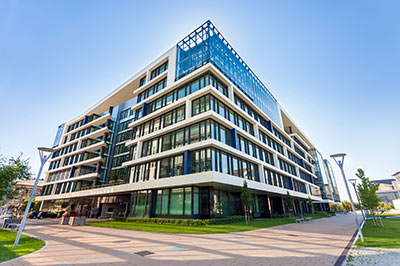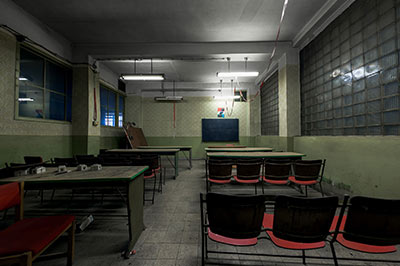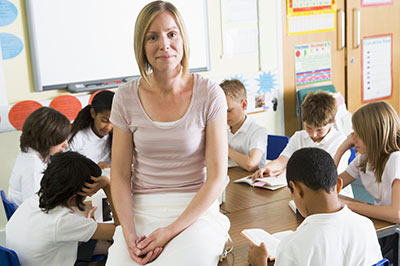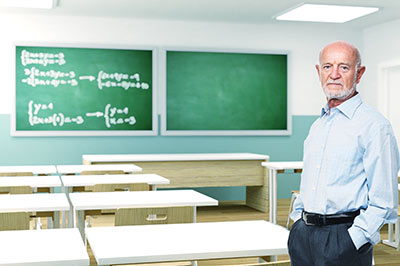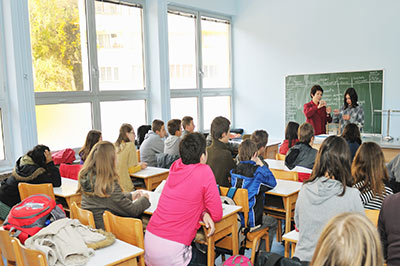By Angel Ford
She’s been teaching elementary grades for over 30 years. At times she’s been in clean, well maintained classrooms with plenty of functional desks. At times she’s been in classrooms with broken fixtures and a shortage of desks.
This year the poor conditions are just too much. She has a student that can’t fit into any of the desks and has to sacrifice her own workspace just so he has a place to sit. It’s December and she’s going on her second month without heat. She encourages her students to wear gloves in the classroom.
The lighting is out in one corner of her room so that students struggle to see their books and assignments. One of her students recently broke a leg and is in a wheelchair. The classroom is so small that he has to sit in the doorway—creating a safety hazard, while at the same time bringing in the added distraction of hallway noise.
In addition to these struggles, the custodial staff has been reduced and classrooms are only cleaned once a week. Teachers are expected to take out their classroom trash daily.
The problems reach beyond individual classrooms. Right now a couple of the stalls in the girls’ bathroom are not working, so bathroom breaks take longer than usual, taking time away from instruction. The playground has equipment that is cordoned off because of safety concerns, so the children have less encouragement for physical activity while outside for recess.
Sure, there had been other trials increasing over the past few years too, such as administrative turnover and increases in high stakes testing. Yet it is simply too much to ask of an educator trying to teach children to read and perform mathematic computations, to be in a classroom without appropriate climate control, and to have to keep it clean throughout the week, and then to sacrifice safety, to accommodate an injured child.
She knew a couple of the newer teachers who were looking for positions in other local schools that were in better physical condition, but she was just too tired. She would retire early. Her plan had been to work a couple more years, but now she just didn’t feel she would have the energy. She walked down the hall—picking up wadded papers along the way—and slipped her letter of resignation into her principal’s mailbox. She would do her best to make it through the next two months. She loved her second graders and she would miss them, but her bones ached from the cold and she didn’t have the energy to explain to parents why their students had to bundle up to sit in her classroom.
There were many factors leading to her decision, but the one in the front of her mind was the physical condition of her classroom and the rest of the school.
The story above is a fictional portrayal of actual situations I have personally witnessed or heard about from educators. This scene, or ones close it, plays out all too often in school buildings around our nation. We have a growing problem of teachers leaving the profession, and I propose that one factor is the increasing deterioration of the physical conditions in which they must work and teach.
Evidence shows that teachers in facilities that are in poor physical condition have more negative attitudes about their classrooms than teachers in good facilities (Earthman & Lemasters, 2009). With over half of the schools in America in need of repairs to be in ‘good’ condition (NCES, 2014), a great number of teachers are working in suboptimal conditions. Add to this the fact that if the school buildings are in poor shape there is often the companion problem of not having enough resources available, and frustration increases (Uline & Tschannen-Moran, 2008).
Emphasis must be placed on maintaining learning spaces that are in acceptable condition and improving those that are not. Investing in school buildings is one way to invest in the teachers that use the spaces (Buckley, Schneider, & Shang, 2005). Providing safe and healthy school environments may encourage educators to stay in their field.
References
Buckley, J., Schneider, M., & Shang, Y. (2005). Fix it and they might stay: School facility quality and teacher retention in Washington, DC. The Teachers College Record, 107(5), 1107-1123.
Earthman, G. I., & Lemasters, L. K. (2009). Teacher attitudes about classroom conditions. Journal of Educational Administration, 47(3), 323-335.
National Center for Education Statistics (NCES). (2014). Condition of America’s public schools facilities. Retrieved from http://nces.ed.gov/pubs2014/2014022.pdf
Uline, C., & Tschannen-Moran, M. (2008). The walls speak: The interplay of quality facilities, school climate, and student achievement. Journal of Educational Administration, 46(1), 55-73.
Angel Ford is a research associate with Education Facilities Clearinghouse, where she is actively involved in research and content management of the EFC Website. She is also currently pursuing her Doctorate in Education with her dissertation topic in the area of educational facilities.

